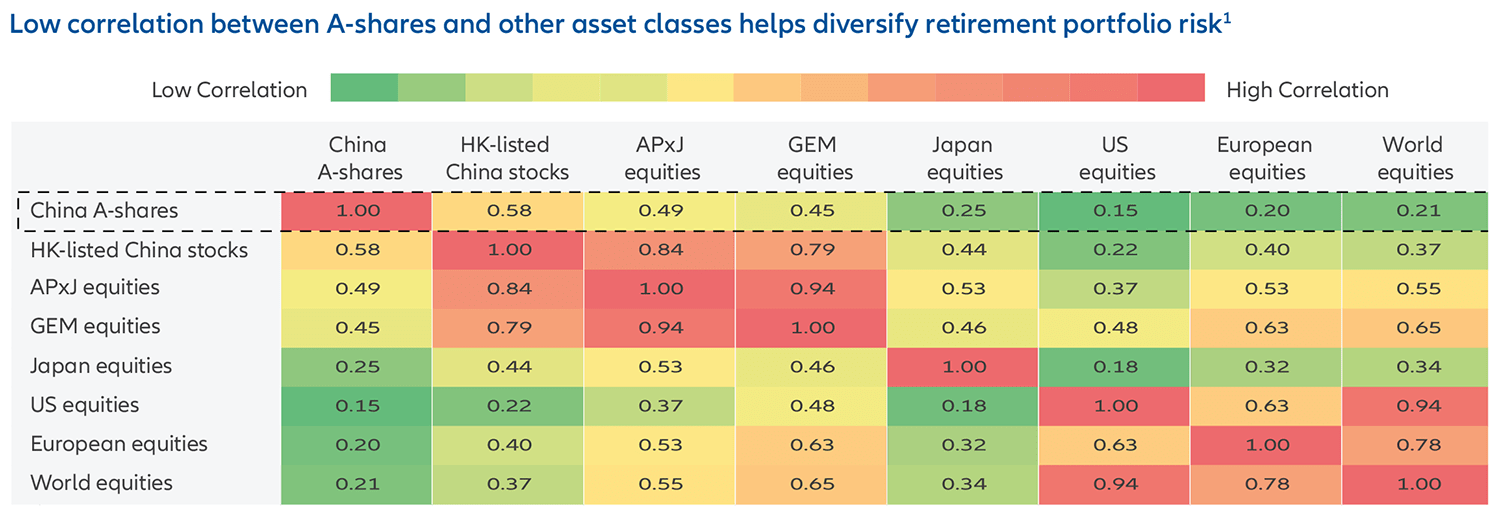China A-Shares Add Color and Diversification to Your Retirement Investments

Summary
Considered one of the most successful investors in the world, Warren Buffett’s number one rule when investing is “Never lose money”. In reality, however, it’s impossible to dodge the twists and turns of the economic cycles and short-term fluctuations in financial markets. How should we manage the downside risks of our hard-earned money?
Key takeaways
|
As with all investment strategies, diversification is an integral part of a retirement portfolio. One way to diversify risk is to consider adding some low-correlation assets to the portfolio. For example, China A-shares are less correlated to other stock markets.
Lower Correlation with Other Markets
Correlation is also known as the correlation co-efficient. In the financial world, correlation is often used to indicate the relationship of price movements of different assets. If the correlation between stock A and stock B is +1, this means that they are moving in the same direction. Conversely, if the correlation between stock A and stock B is -1, it means that they are moving in opposite directions.
Data shows that the correlation between China A-shares and Hong Kong-listed Chinese stocks was 0.59 as of March 31. Meanwhile, the correlation of A-shares with European and US equities was as low as 0.20 and 0.15, respectively. What is the explanation for the relatively low correlation of A-shares with the major markets? We suggest two possible reasons.
First, the nascent mainland A-share market is dominated by retail investor trading while global institutional investors play a secondary role. As a result, China’s unique economic, political and monetary policy directions stand to be more influential in moving capital market prices rather than global macro trends.

Domestic Revenue is the Powerhouse of A-share companies
Second, companies listed in the A-share market are active in the new economy sector, targeting the domestic consumer base. In fact, most of the revenue streams of these companies are generated within China. Thus, the Sino-US trade situation has less obvious impacts on the A-share market. The domestically-facing revenue base shields A-share compa-nies from global macroeconomic changes. Instead, the policy direction set by the Chinese authorities and the People’s Bank of China proves to be more material. Traditionally, China sets fiscal and monetary policies at its own pace, with little correlation to European and US policies.
In other words, adding A-shares to a retirement portfolio will help employees tap into different markets and sectors, especially the “new economy” sectors that enjoy structural growth. Meanwhile, the correlation of portfolio assets will play a part to balance risk, and ultimately improve long-term risk-adjusted potential return.
1 Source: Bloomberg, Allianz Global Investors, as of 31 March 2021. Correlation is based on historical weekly returns (in USD) of the respective MSCI indices over the past 10 years.
Active vs Passive? Your Guide to Retirement Investing

Summary
Enjoying a well-deserved retirement with a generous savings reserve is considered a life goal by many workers. The dream is not unattainable, but it requires a proactive mindset in managing your retirement portfolio.
Key takeaways
|




